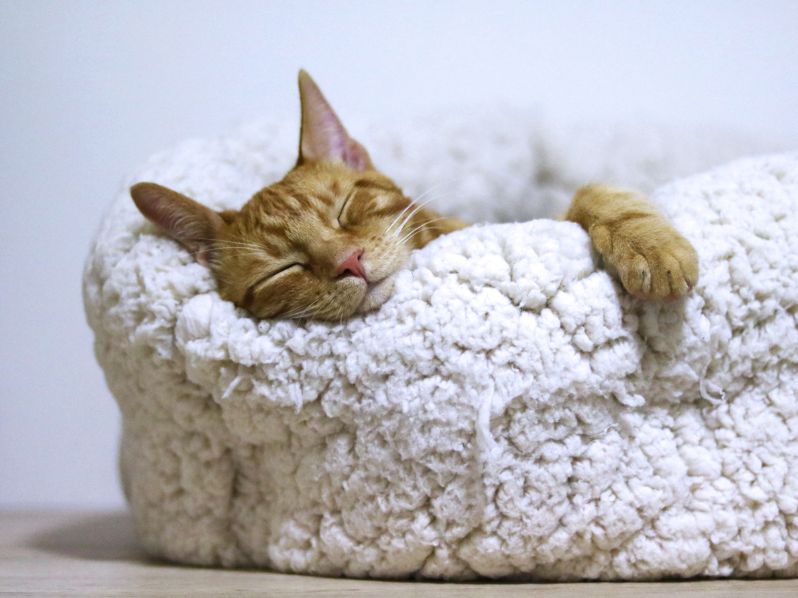
How to Identify and Solve Your Cat’s Separation Anxiety
This post may include affiliate links. Please read my disclosure policy.
Does your cat yowl or start racing through the house when you’re getting ready to leave? Do you find destroyed drapes or poop on the floor when you return? If so, your cat may be suffering from separation anxiety.
Some pet parents, however, may miss these signs of anxiety for one major reason – they don’t think their cat could have it.
Can Cats Have Separation Anxiety?
Contrary to popular belief, cats are not always solitary creatures and can indeed experience separation anxiety. While this is often overlooked in cats, it’s crucial to recognize the signs. This is especially true for cats who were orphaned or who are suddenly alone after long periods of being with their humans.

They are the boss of their surroundings and they’re a bit of type A personality. This means when something is out of order, like their human being gone when they’re usually at home, it causes them stress.
In a survey conducted by Ceva Animal Health, nearly 60% of cats in US households showed signs of stress or anxiety.
Is Separation Anxiety Harmful to Cats?
Yes. A cat can be temporarily stressed, but when it persists it leads to anxiety and associated behaviors. If you’re planning on getting a cat or currently have a cat, don’t assume that you can be gone for long periods of time and the cat will be ok.
Over time, anxiety affects the immune system and can lead to a higher prevalence of disease and harm your cat’s quality of life.
That’s why it’s important to know the signs of separation anxiety in cats – and how to help our feline friends overcome it.
9 Signs of Cat Separation Anxiety
Cats are great at picking up on our patterns and routines. Hibiki, a rescue cat in the Pet Living family, can always tell when his pet mom, Alyssa, is getting ready to leave the house.
“I don’t know how, but he always knows long before I grab my keys or head out the door – and he always gets excited and begs for a treat as soon as he figures it out,” Alyssa said. “I gave him one once, and it’s become a tradition. He also can tell when I’m only getting ready to go outside to garden or ride my bike and won’t beg those times.”
For many cats, though, signs that their pet parent is leaving fill them with anxiety. But how do they show it?
You may see some of these signs when you’re preparing to leave, or you may see them when you return.

1. Increased Vocalization
Cats don’t generally meow at other cats. Most cats reserve their meows for humans. So if you hear your cat meowing more than usual – or even yowling – when you’re getting ready to leave, they may be feeling anxiety.
2. Overgrooming/Hair Loss
While cats usually groom to clean themselves, it also can be a way to self-soothe. An anxious cat may groom themselves until they develop bald patches in their fur.
3. Pacing/Restlessness
Most cats get “the zoomies” from time to time. But if your cat only goes into hyperdrive when you’re leaving, they may be getting stressed.

4. Hiding
Hiding is a very common sign of a stressed cat. Your cat may hide under the bed or in a closet. They’re looking for a place to feel safe and secure to comfort themselves.
5. Clinginess
If your cat doesn’t want you to leave, they may become very clingy. This may include following you around the house or begging to be held.
6. Destructive Behavior
Destructive behavior includes scratching, chewing, or shredding. When you come home and find your normally non-destructive cat has clawed the curtains or scratched up a door frame, anxiety may be to blame.
7. Litter Box Issues
Litter box issues include peeing or pooping outside the litter box. This can also be caused by various medical conditions. Consult your veterinarian to eliminate any medical reasons first.

8. Aggression
Aggression could be toward humans or other animals. This includes things like swiping at your ankles as you walk down the hall. Your cat also may hiss at or start fights with any other cats or dogs in your family.
9. Twitching or Trembling
Humans may tremble when they’re frightened, too, but it looks a little different in cats. Twitching or trembling may include flicking their tail back and forth or moving their ears around.
If you regularly see any of these signs when you leave your house or return, it’s likely your cat has separation anxiety. But what can you do to help?
Pin me!

How to Help Your Anxious Cat with Their Separation Anxiety
No one likes to see their cat suffer from anxiety. But most pet parents don’t know what to do about it. In fact, in the same survey mentioned above, 23% of pet parents of anxious cats said they didn’t know what to do about their cat’s anxiety. And another 37% decided to simply wait and see if the issue resolved itself!
Sadly, behavioral issues don’t generally go away on their own. But that doesn’t mean it’s a hopeless situation! There are many things you can do to help.

1. Talk with Your Veterinarian
If you suspect your cat has separation anxiety, speak with your veterinarian. They can make sure there aren’t any medical issues at play. Depending on how severe your cat’s anxiety is, they may recommend a supplement or medication.
2. Don’t Make a Big Deal Out of Leaving
It may be tempting to pet your anxious cat or give them extra attention before you leave. Ironically, this may do more harm than good. That’s because it makes your leaving an “event.”
The more low-key your departure is, the better. If possible, put your keys, purse, or other items in your car well before you actually leave.
If you notice a specific trigger is making your cat anxious, use it “out of order.” For example, if your cat starts meowing when you pick up your keys, try picking the keys up and walking around for a bit. Then put them back without leaving home. By setting off your cat’s triggers without actually leaving, your cat will gradually become less sensitive to them.

3. Keep Them Entertained
Even when you’re not there, you can entertain your cat. Make sure they have perches where they can see the outside world. Toys should be available, too. See my favorite recommendations for enrichment here.
Food puzzles can be a great way to entertain your cat. They stimulate your cat mentally, occupy their time, and give them a fun reward at the end.
4. Try a Pheromone Diffuser
Pheromone diffusers, like this one from Feliway, help calm your cat when you’re not home. They work by sending out the natural pheromones a mother cat gives off to calm her kittens.

5. Create a Safe Place for Them
Make a safe and cozy haven for your cat where they can find comfort when you’re gone. This may include a comfortable cat bed in a tucked-away corner. It also may include their favorite toys – or even a shirt you’ve worn that has your scent.
6. Monitor Your Pet
Your cat’s safety and well-being are a top priority. However, when you’re not home, you may feel out of touch with your pet. Pet cams allow you to monitor your pet’s health as well as identify any signs of separation anxiety when you can’t be there personally.
7. Consider a Veterinary Behaviorist
If you are not having any success with these methods, consider consulting a veterinary behaviorist. These specialists focus on helping animals conquer their fears and behavioral issues. Go to dacvb.org to find a veterinary behaviorist near you.
The Tail End
Separation anxiety can cause our feline friends a lot of distress, but it doesn’t have to be that way. By knowing the signs of cat separation anxiety, we can be ready to give our furry family members the help they need to live happy, anxiety-free lives.







Comments (0)